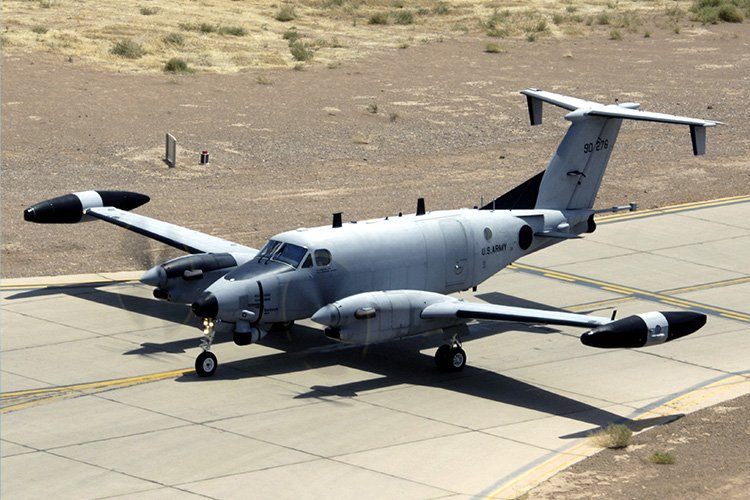The U.S. Army is looking to upgrade its aging fleet of intelligence, surveillance, and reconnaissance (ISR) aircraft by advancing the development of its next-generation airborne ISR system, codenamed the High Accuracy Detection and Exploitation System, or HADES.
In a special request for information issued last week by the Army’s Program Executive Office Aviation, in coordination with the Space, Missile Defense, and Special Programs Directorate at Army Contracting Command, officials requested feedback from industry partners regarding the development of three HADES prototypes.
Information on the development of HADES is primarily considered TOP SECRET/Sensitive Compartmented Information (TS/SCI), and details are sparse as to precisely what type of feedback the Army is looking for.
In the recent notice, Army officials ambiguously mention that industry input is desired for “market research and planning purposes,” along with “feedback (both positive and negative) on the Controlled Unclassified Information” related to the development of three HADES prototypes.
The Army intends to meet with potential industry partners one-on-one during the Army Aviation Association of America Symposium in Nashville, Tennessee, on April 24-26. Participants must meet unspecified security requirements and hold an active TS/SCI clearance to schedule a one-on-one meeting to discuss HADES.
Initially launched in 2019, program documents make it clear that HADES, itself, isn’t a new spy plane. Instead, the program involves the development of a next-generation airborne sensor suite capable of peering deep within an enemy’s denied airspace.
The solicitation notice describes HADES as “a key enabler to Army Long-Range Precision Fires by directly mitigating deep-sensing gaps in Large Scale Combat Operations.”
The Long-Range Precision Fires (LRPF) program mentioned in solicitation documents is one of the Army’s top priorities. With its LRPF efforts, the Army intends to introduce a number of new ground missile and artillery systems with deep-strike capability and effective ranges exceeding 186 miles (300 km).
Within the LRPF framework, HADES could assist in long-range target designation and surveillance of enemy positions.
According to the Army’s recent notice, the prototype HADES systems will be outfitted and tested on “government-furnished” Bombardier Global 6500 aircraft.
Since 2020, the Army has been using modified Bombardier CL-650 aircraft to test a surveillance gathering system known as “ARTEMIS” developed by Leidos and an electronic warfare platform by L3Harris called “ARES.” Last year, both systems were used to carry out real-world surveillance missions over Europe and the Pacific.
During a media day in 2022, Ronald Rizzo, deputy project director for sensors aerial intelligence at Program Executive Office Intelligence, Electronic Warfare, and Sensors, told reporters that testing of ARTEMIS and ARES was “meant to prove the Army can put its latest intelligence tech on a more modern aircraft.”
“It’s collecting, we’re learning from it. It comes back to the States every few months. We iterate the software, we iterate on different sensors, hardware, and back out again,” said Rizzo. “All of this is to inform how we will ultimately build the HADES program of record.”
Whether a HADES-outfitted Bombardier Global 6500 will become the Army’s next-generation spy plane is unclear. When speaking at an Army event at Aberdeen Proving Ground, Rizzo suggested the eventual HADES spy plane could be an uncrewed aircraft.
Program documents also note that HADES is being developed under a “Modular Open Systems Approach” (MOSA), meaning that the final version could be easily swapped in and out of multiple different types of aircraft.
Aside from two ARTEMIS and ARES testbeds, Army airborne ISR and electronic warfare missions are currently being carried out by the nearly 50-year-old turboprop aircraft: the de Havilland Canada EO-5 and Beechcraft RC-12.


In a recent statement, the Army described its current fleet of over 60 ISR aircraft as “remnants of the Cold War.”
“Originally built for Cold War and counterterrorism threats, current and future multi-domain operations, as well as geographical and geopolitical changes, create challenges with the old fleet,” the Army wrote. “Threats to assured communications are increasing, resulting in a need to design a concept and build material solutions for likely scenarios that do not rely on access to allied military installations to continue the mission.”
“The solution to these challenges is the High Accuracy Detection and Exploitation System or HADES.”
Army planners say that HADES will eventually represent an ISR aircraft that can “fly faster, longer, and higher” than its predecessors while also allowing for the ability to tailor different capabilities for specific missions.
“With the ability to fly higher, farther, and faster in the various target areas that we’re looking at, we get vast amounts of data every mission that we fly. It is vastly different because we are able to stay in an area for a longer dwell time,” said Sgt. Bryden Jones, a mission manager for ARES with the 104th Military Intelligence Company, PED Battalion, 116th Military Intelligence Brigade.
“These capabilities allow us to provide things like pattern-of-life; it allows us to see up and down time locations, potential troop movement or anything else you can think of.”
“This modernization effort, going from our legacy platforms to our current modern platforms, is absolutely a step in the right direction,” added Jones.
“We have stepped away from the counterterrorism operations and started looking at bigger, wider, more strategic objectives in order to effectively provide intelligence to the people that need the information to win the nation’s wars.”
Tim McMillan is a retired law enforcement executive, investigative reporter and co-founder of The Debrief. His writing typically focuses on defense, national security, the Intelligence Community and topics related to psychology. You can follow Tim on Twitter: @LtTimMcMillan. Tim can be reached by email: tim@thedebrief.org or through encrypted email: LtTimMcMillan@protonmail.com

